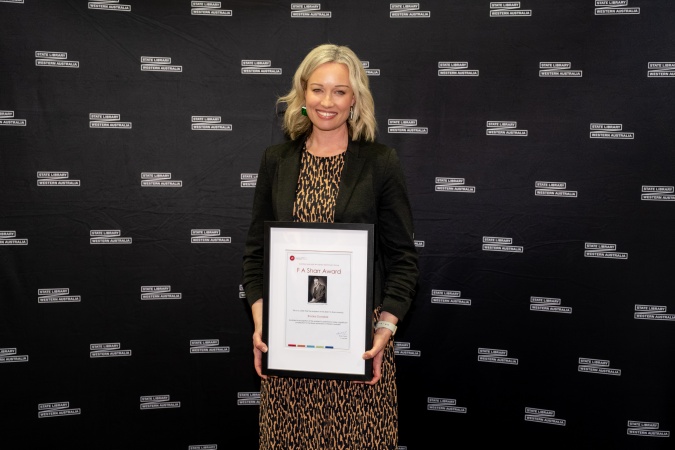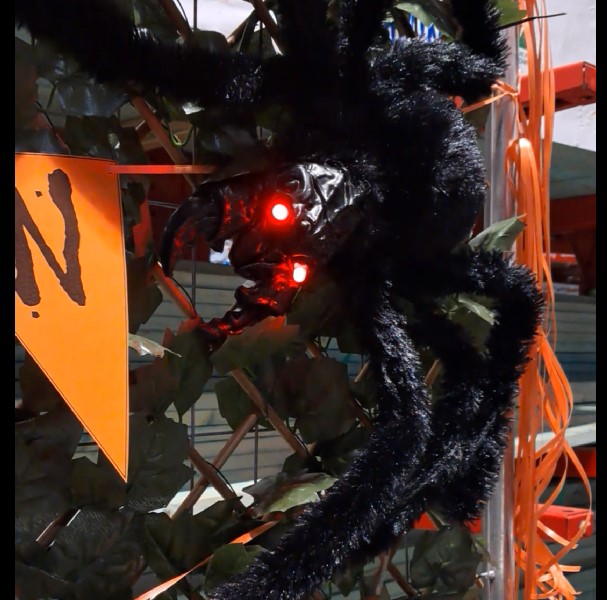
(Image credit: https://slwa.wa.gov.au/)
A few weeks ago, something incredible happened: I was honoured to receive the FA Sharr Award – a recognition given to early career library professionals in WA. I won it for speaking on a topic I care deeply about: how graphic novels are changing the literacy game.
Now, before you picture a slick speech delivered from a podium with perfect posture – let me paint a more accurate picture: me, nervously speaking to a room full of esteemed library professionals, wishing I could just swap them out for a bunch of squirmy Year Threes.
Someone advised me just to imagine the audience as children. Naturally, I started with a fart joke. Because truly – once a children’s librarian, always a children’s librarian.
When I was about eight years old, my mum took me to the State Library of Western Australia to research mermaids. We scrolled through old newspaper clippings on the microfiche machine, and I remember riding the glass elevator down and thinking: these are my people. That was the first time I ever thought, I want to be a librarian.
Fast forward a few decades. I’d left a not-so-family-friendly career in publishing, had two wonderful chaos agents (aka children), and found myself wondering: what now? My husband, ever the realist, asked what I actually loved doing. The library was still calling.
So I answered. I finished my Grad Dip in Library and Information Studies at Curtin in 2021 and began working in a primary school library – the best career move I ever made.
But, dear reader, we have a problem…
We are living through a full-blown attention crisis. Johan Hari’s Stolen Focus, Jonathan Haidt’s The Anxious Generation, Dr Gloria Mark’s Attention Span – they’re all saying what every teacher and parent already knows: we are losing the ability to focus, and fast.
The stats are grim:
-
One in three Australian students don’t meet the expected NAPLAN reading standard.
-
In 2021, a quarter of Australian adults didn’t read a single book.
-
In the UK, reading enjoyment among 8-18-year-olds just hit a 20-year low.
This isn’t just about literacy – it’s about the kind of society we’re shaping.
Enter: the graphic novel. Let me say it loud for the people in the back: graphic novels are real books.
They’re not “less than.” They’re not “baby books.” And no, pushing kids to read “harder books” doesn’t magically instil a love of reading. It usually just turns reading into a chore.
Graphic novels turn reading into a joy. Kids flock to them. They reread them. They hoot and holler over them. They share them like rare treasures. They race to the library to be the first to borrow them.
Surely something that enjoyable can’t be good for you? Fear not! Graphic novels:
-
Promote literacy;
-
Improve a reader’s ability to infer and empathise;
-
Enhance critical thinking;
-
Are full of artistic merit;
-
Contain more rare word per thousand than an adult novel;
-
Require more complex cognitive processing than a standard novel; and
-
Explore diversity and complex social issues in an accessible way
And the data? Delicious.
-
In the past five years, student borrowing at our school has increased overall by 33%.
-
In the last 12 month period, fiction loans are up 16%, but graphic novels: up 30%.
-
In 2024, we hosted local author Sean E. Avery. His graphic novels have been borrowed 180 times in 12 months. That’s not a fluke. That’s a success story!
So why are we still side-eyeing them? I still hear people lament: “But it’s not proper reading…” To which I say: Really?
If a child is curled up, laughing, lost in a book – I don’t care if it’s got 1,000 words or 10,000. That’s reading. That’s joy. That’s what we should be nurturing. Heck, I’ll celebrate a reluctant reader poring over a cereal box at breakfast. Kids infatuated with graphic novels? We should be shouting from the rooftops: THESE KIDS ARE READERS!
I’m not throwing out the classics. I still read over 150 picture books and novels to my students every year. But I am gently, persistently, lovingly, pushing for change.
Graphic novels belong in every library. On every shelf. In every classroom.
Because the more our students are reading, the better.
TL;DR: Let them read graphics.
-Brooke Donabie
References:
Dougherty, C., & Robinson Gregg, C. (2024). Graphic novels as the forger’s tool for literacy. “English in Texas”, 54(1), 46–52.
https://eric.ed.gov/?id=
Ganessingh, R. (2025). Using comics and graphic novels to promote literacy in libraries. The Alma Jordan Library.
https://uwispace.sta.uwi.edu/
Loftus, L. (2025, July 6). The allure of graphic novels. Georgetown Day School.
https://www.gds.org/
Australia Reads. (2021). Who are the readers? National Reading Survey.
https://australiareads.org.au/
Throsby, David, Jan Zwar and Callum Morgan (2017). Australian book readers: Reading habits and preferences.
https://creative.gov.au/sites/
National Literacy Trust. (n.d.). Reading for pleasure.
https://literacytrust.org.uk/
United Through Reading. (n.d.). The benefits of graphic novels: Why they count as reading.
https://unitedthroughreading.



0 Comments